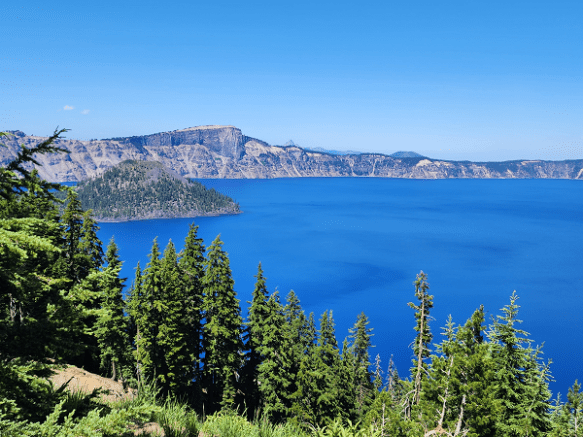Crater Lake National Park Travel Guide
As we approach the launch date of our new nomadic life we have been discussing all the things we haven’t seen/done in and around our hometown of Redmond, Oregon. I have very vague recollections of visiting Crater Lake National Park as a small child and Sandra thinks she may have seen it but wouldn’t swear to it. It likely would have been a side trip on her family’s military move when she was pretty young.
Okay, we definitely need to do it; I mean, for the past 20 years we’ve lived 2 hours away from an area that people travel from Europe and Asia to see. In fact, during our day trip I heard for sure 4 other languages being spoken besides English – Italian, German, Japanese I was able to ID pretty easily. My brain immediately tagged the fourth as Sri Lankan without having any idea what that even means – just a snippet of conversation overheard in passing and that’s what crumped into my fron.
So here’s what we did and a couple of tips to make the most of your day at Crater Lake National Park
Day Trip to Crater Lake National Park
Crater Lake is not just another lake
Crater Lake is located in Southern Oregon on the crest of the Cascade Mountain range, 100 miles (160 km) east of the Pacific Ocean. It lies inside a caldera, or volcanic basin, created when the 12,000 foot (3,660 meter) high Mount Mazama collapsed 7,700 years ago following a large eruption.
At 1,943 feet (592m), Crater Lake is the deepest lake in America. In addition, 100% of the fill is from snowmelt and rainfall; there are no inlets. Average annual snowfall exceeds 40 feet (12 meters)
Over 600,000 people visit Crater Lake National Park each year. Most of them (like 2/3) during the June to September time frame
Best Things to do at Crater Lake National Park
Crater Lake Rim Drive
Everyone talks about the 33 mile lint Rim Drive as the best way to experience the immensity and beauty of this collapsed caldera than by cruising along the scenic 33 mile Rim Drive? The road traces the rim of the crater, offering breathtaking viewpoints and captivating glimpses into the park’s volcanic history.
If you come in from the north entrance like we did, you have the option of either going left or right to take either the East or West Rim drive. We chose to go left even though most of the East Rim drive is closed at Cleetwood Cove Trail head for construction, as there are still plenty of viewports, trails and picnic spots before the closure that have great view points. We just had to turn around and back track once we got tot he closure.
- North Junction: This is your starting point if you’re coming from the park entrance near Munson Valley. Here, you’ll have your first glimpse of the caldera and Wizard Island.
- Watchman Overlook: This is one of the most popular viewpoints on the Rim Drive. Here, you can see evidence of pyroclastic flows and learn about the volcanic history of Mount Mazama. The Watchman Peak Trailhead is also located here, offering a challenging hike to the top of the cinder cone for truly panoramic vistas.
- Discovery Point Trailhead: This short trail leads to the rim of the caldera for an even closer look at the lake.
- Park Headquarters & Rim Village: This is the hub of the park, offering visitor services, restaurants, and lodging options. Take a break, explore the facilities, or grab a bite to eat before continuing your journey.
- Castle Crest Trail: The short trail is relatively easy 0.4-mile loop trail perfect for those seeking a leisurely stroll through the park’s meadows.
- Vidae Falls: Vidae Falls is located on the southern flank of Crater Lake, just east of the park headquarters on the East Rim Drive. This stunning waterfall cascades down 115 feet and provides a refreshing change of scenery and a chance to experience the park’s water features.
- Sun Notch Trail: The 0.8-mile loop is open year-round and is a flat and easy trail with plenty of lookouts to view the mysterious Phantom Ship.
- Phantom Ship Overlook: Phantom Ship Overlook provides one of the best views of the Phantom Ship along Rim Drive
- Pumice Castle Overlook: The volcanic formation is an eye-catching orange and pink in the shape of a medieval palace. Located along the East Rim Drive, between Cloudcap Viewpoint and Phantom Ship Overlook
- Skell Head: Skell Head stands out because the glacial striations, or scratch marks left by glaciers on the rock surface, run in a different direction compared to most of the caldera rim. It’s a specific point on the caldera rim located between Round Top and Munson Point on the northeast side of the lake.
How to really see Crater Lake – a lesson learned
In hindsight, the Crater Lake trolley tour is probably a really good value. It’s hard to drive and sightsee at the same time. We overheard a couple of the tour stops and the trolley provided guide presented a fair amount of info about the lake and the park. If we had it to do over I think we would arrive in time for the 9 am trolley tours and then have our picnic after the 2 hour tour.
Another benefit to doing the trolley tour over driving is that a couple of the overlook parking areas were very crowded and who needs that stress? We skipped one simply because waiting for a space to open up didn’t seem like a great use of our time. Maybe it’s a minute, maybe it’s 20? To be fair it was also the last (accessible) overlook on the East rim and we were just about over it at that point.
Speaking of the last accessible overlook – check road conditions before you make your plans to visit Crater Lake Park. The lake surface at Crater Lake is at 6,178′ elevation (1,882m) although that rises and falls slightly depending on water level, imagine that. The rim drive ranges from 6,500′ (1,981 m) to 7,900′ (2,407 m) so it’s not uncommon for portions of the East rim drive to be closed for snow well into July and then close again in October. In this case, the closure of the East Rim Drive on the north side to just east of Cleetwood Cove trail to Grotto Cove was due to construction but when we decided back in June to make the trip there were still snow closures in effect.
We actually did see fairly large patches of snow still on the ground as we trekked around the rim drive at nearly the end of July
Take a hike, man
Throughout the park and along the rim drive there are a lot of trails. However, they are mostly not things you would just suddenly decide to do – from the rim to the lake is quite a drop and walking down is probably a dawdle but coming back up would be far more ‘interesting’.
There is and information sign at one of the overlooks helpful guide to the level of effort for various hikes (I never saw this on the website – we weren’t planning on hiking so I didn’t really look) .
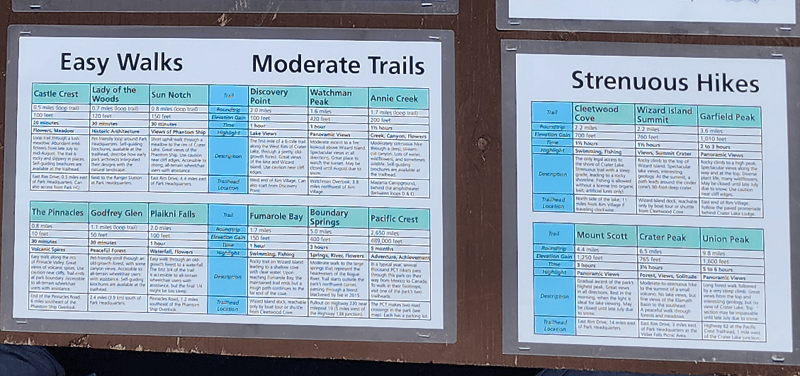
Had I been wearing somewhat sturdier shoes and carrying a little extra water there were one or two I might have chanced on a whim but with no daypack nor extra water bottle and just my Skechers as footwear I wasn’t super comfortable with the idea
Watch our Crater Lake Day Trip video
How to Get to Crater Lake National Park
Just getting to Crater Lake can be a trip
Coming from Bend, OR it’s about 2 hours on the road if you take the direct route and mostly observe the speed limit. From Klamath Falls it is around an hour and a half. Having said that, if you are headed out from Bend/Redmond area there are several far more scenic ways to travel with commensurately longer drive times. If you want to really make it a road trip then the Cascades Lake National Scenic Byway route is the way to go although it will more than double your drive time. I would plan to actually make that an entire day and visit some of the other scenic lakes along the way.
Our drive down was pretty uneventful, Highway 97 to Highway 138 to Crater Lake Hwy N/Volcanic Legacy Scenic Byway and the north entrance. Most of the last 40 miles or so looks a lot like this –
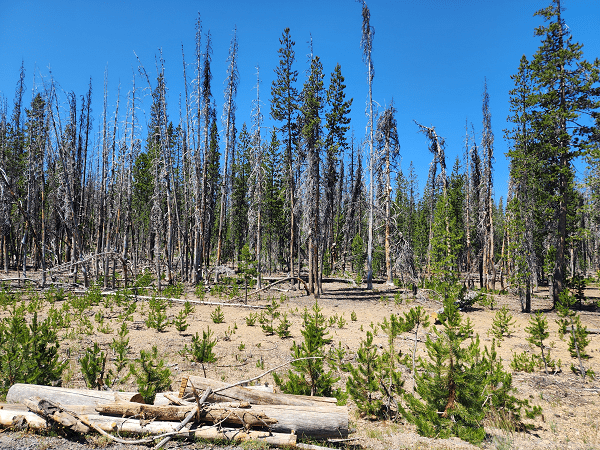
Are we there yet?
The United States National Park Service manages traffic into the park. We rocked up at a little after 12 to find a fairly long line waiting at the pay station. Guessing there were 50 to 60 cars ahead of us. We were about 35 minutes into the wait when a little boy walked by counting cars and tagged us as 23. (The family walked up from the cars behind us, walked to the front and then he was counting on the way back.)
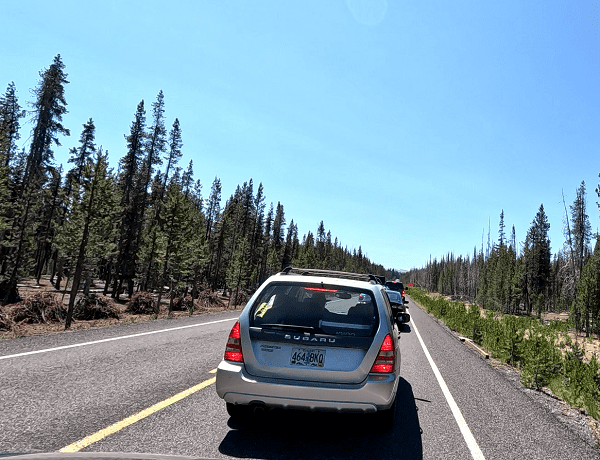
It was less than an hour in the queue (but not by much) until we reached the north entrance pay station. Before you go, look at the various pass and payment options available on the National Parks website to see if you can save a few $$’s. If you are going to be visiting multiple parks on during your trip to Oregon you might benefit from buying an annual pass.
In related news, when planning for a trip or an excursion with a partner you need to have open and clear communication. I was shocked to find a line that long just to enter Crater Lake National Park; Sandra had completely anticipated it due to our late morning departure schedule. Rather than saying anything ahead of time, she assumed I was aware and comfortable with the idea of having to wait. We had a conversation along the lines of the old cliché ‘If you see something, say something’ so we can hopefully avoid these sort of varying expectations in future.
Recap: How to Get to Crater Lake National Park Recap
By car: Crater Lake National Park is located in southern Oregon. The easiest way to get to the park is by car. There are three entrances to the park:
- Rim Village Entrance (from the north): This is the most popular entrance to the park. It is located off of Highway 138, about 30 miles east of Medford, Oregon.
- Munson Valley Entrance (from the southwest): This entrance is located off of Highway 62, about 25 miles west of Klamath Falls, Oregon.
- Steel Bridge Entrance (from the south): This entrance is located off of Highway 62, about 30 miles southeast of Klamath Falls, Oregon. This entrance has limited services and may close during the winter.
By airplane: Your best bet if you’re flying in is to fly into the the closest airports; Medford (MFR), Eugene (EUG) or Redmond (RDM), respectably, and rent a car. You can also fly into Portland (PDX) but if you’re sole purpose is a day trip to Crater Lake you’ll spend most of your day on the road because Portland is 4 hours from Crater Lake. I recommend flying into Redmond (RDM) and basing yourself in Redmond, Oregon for the weekend. It more affordable than Bend and is an amazing town!
What to eat while you’re at Crater Lake
Food at the lodge is neither inexpensive nor exotic. I had looked at the menu for the restaurant at Crater Lake Lodge as well as the one near Mazama Village and decided that a $20 burger wouldn’t make for a more enjoyable day. We grabbed sandwich fixings – rolls, cheese, lunchmeat, chips, a few bottles of water – borrowed a cooler, and we were set up for success.
We just used stuff from the fridge but if we had gone and purchased everything for the trip it likely would have been around $25-$30 and we had enough to make 5 or 6 sandwiches had we really needed them.
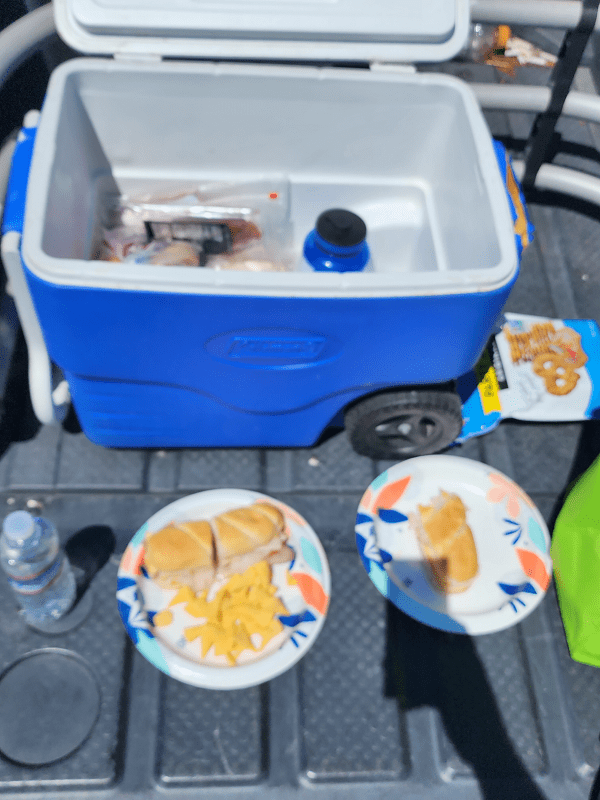
Since we started late in the day, so we chose to stop at the first overlook we came to and had our picnic on the tailgate of the Baja (Raj, if anyone is curious as to the cars name).
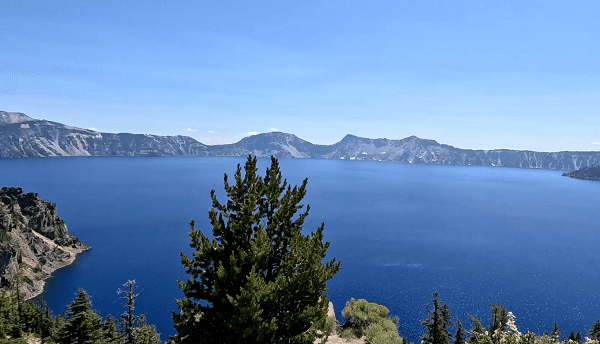
The chipmunks were intrigued. We did not feed them although they are hard to resist because they’re so stinkin’ cute and also quite bold.
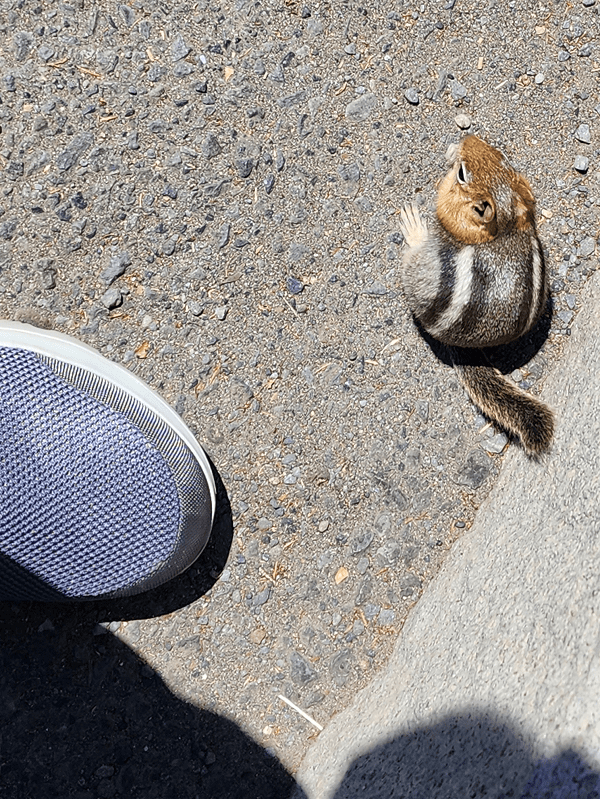
Of course, the view most everyone has seen from Crater Lake is of Wizard Island
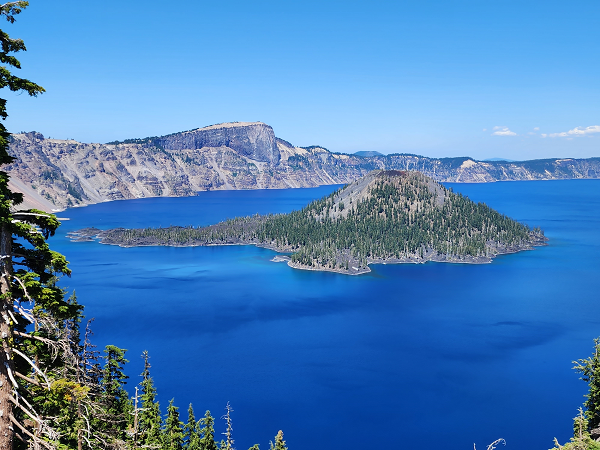
Best Time to Visit Crater Lake National Park
The best time to visit Crater Lake National Park depends on what you want to do during your visit. Here’s a breakdown of the seasons and what you can expect:
Summer (July-September)
- This is the peak season for visiting Crater Lake National Park. The weather is warm and sunny, with average highs in the 70s and 80s Fahrenheit (21-27 °C).
- All the park roads and facilities are open, including the Rim Drive, which offers stunning views of the lake.
- This is also the busiest time to visit the park, so expect larger crowds and higher prices for lodging.
Fall (October-November)
- The weather starts to cool down in fall, with average highs in the 50s and 60s Fahrenheit (10-16 °C). The crowds start to thin out, and the scenery becomes even more beautiful as the leaves change color.
- Some park roads and facilities may start to close in late fall, so be sure to check the park website for current conditions before you go.
Spring (April-June)
- Spring is a shoulder season at Crater Lake National Park, with fewer crowds than summer but also the possibility of rain and snow. The weather starts to warm up, with average highs in the 40s and 50s Fahrenheit (4-10 °C).
- Some park roads and facilities may still be closed due to snow, so be sure to check the park website for current conditions before you go.
Winter (December-March)
- Crater Lake National Park receives a lot of snowfall in winter, and most of the park roads and facilities are closed. The weather is cold and snowy, with average highs in the 30s Fahrenheit (-1 °C).
- However, the park is still open for experienced winter sports enthusiasts who can access the rim by snowmobile or cross-country skis.
Here’s a quick summary to help you decide:
- For warm weather and all facilities open: July-September
- For fewer crowds and beautiful fall foliage: October-November
- For a shoulder season with possible rain or snow: April-June
- For winter sports enthusiasts: December-March (with limited access)
No matter when you decide to visit, Crater Lake National Park is a beautiful place to experience the outdoors. Be sure to pack for the weather conditions and plan your activities accordingly.
Prepare for the weather at Crater Lake
It was quite breezy up along the rim of Crater Lake so it feels cooler than the thermometer might indicate. The forecasted high for Redmond, our departure point, was 87F (30C for those of you in civilized countries) and the forecast high at the park was 70F (a much more pleasant 21C). I was fine in shorts and my standard Aloha shirt but I did wear shoes rather than sandals. There were a couple of overlook points where I would have been more comfortable in trousers or at least with a t-shirt under the short-sleeve shirt. Maybe carry a light windbreaker if you tend to run cold.
The Phantom Ship overlook area is completely shaded so it was the coolest spot by a lot.
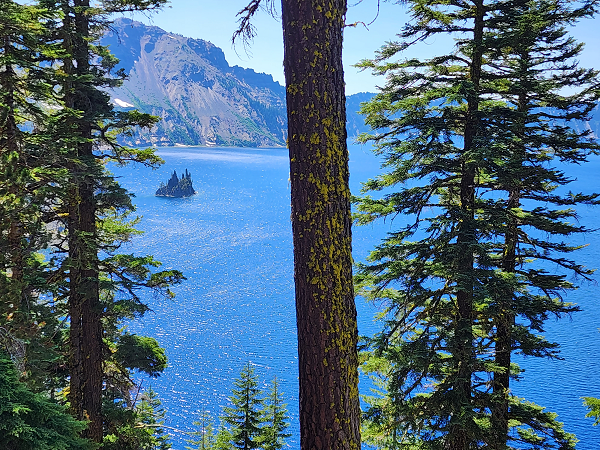
We didn’t bother with the Cloudcap overlook as it goes away from the lake. We’ve seen any number of impressive valley floors in our day so one more wasn’t likely to be impactful.
Insider Tips Recap
Here are some additional things to keep in mind when planning your trip to Crater Lake National Park:
- The park is located at a high elevation (over 6,000 feet), so be prepared for cooler temperatures, especially at night.
- The North Entrance and the Rim Drive close for the winter season!
- The park can get crowded, especially during the summer months. Be sure to book your lodging and campsites in advance.
- The que at the entrances can be quite long. Plan accordingly, go the bathroom before you head out. Bring Snacks.
- There are a limited number of services available inside the park, so be sure to pack everything you need for your trip.
Overall, I would say that Crater Lake National Park is worth a visit and if you’re into hiking it’s probably worth a stop of a couple of days to explore the various trails. We would recommend booking a trolley tour rather than doing a self-drive and I’m sure National Park Service hates this idea but we would recommend packing in your own picnic lunch.
I hope this helps!

